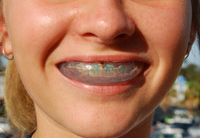4 Must-Know Guidelines For Purchasing A Proper Braces Mouthguard

Fitting an athlete for a mouthguard is one thing, but when your players have braces, it makes your job that much more difficult. Do you need a different type of mouthguard entirely for players with braces? What happens when their teeth move and the guard no longer fits? Are all braces mouthguards the same?
Braces mouthguards are actually not that much different from regular mouthguards, and as you may come to find, they share many of the same characteristics and features.
Here are the four most important qualities to look for when purchasing braces mouthguards for your team:
1. It Must Stay In Place
Quick: what’s the number one reason for your players to wear mouthguards?
For protection, obviously! But, mouthguards only protect if they’re worn properly.
Many braces mouthguards are not form fitting, which means they tend to float in the player’s mouth or require the athlete to constantly bite down in order to hold it in place. In either case, that is very dangerous and defeats the purpose of wearing a mouthguard in the first place.
When a mouthguard doesn’t fit correctly, there is no guarantee the mouthguard is going to be in place when impact comes. Whether your players have braces or not, it’s essential to make sure that their mouthguards stay in the proper position without them needing to bite down.
2. It Must Allow Room To Move
Braces help to slowly move the teeth into the desired position for a perfect winning smile. So, when teeth don’t have room to move, braces become ineffective — something parents, and the braces-wearer, certainly don’t desire.
Mouthguards that press too tightly against the braces may interfere with the orthodontic work and restrict tooth movement. Proper braces mouthguards are the best way to ensure your players’ teeth have plenty of room to move.
Designed to allow movement and growth, braces mouthguards assist in holding the guard in place, while providing proper space for the teeth to move into a new position.
3. It Must Be Comfortable
While a braces mouthguard must allow for tooth movement, it must do so without resting against or irritating the brackets. This causes a great deal of discomfort for players with braces, and as you may recall from your adolescence, braces aren’t the most comfortable thing to wear to begin with.
That means your athletes’ braces mouthguards must not be too bulky, while still allowing room for the brackets to be adjusted by the orthodontist while the mouthguard is worn. Extra bulkiness will inhibit your players’ ability to breathe and communicate properly.
When mouthguards are engineered to fit each player’s specific mouth structure, they aren’t bulky where comfort is needed, meaning your players have the ability to speak and breathe clearly. Those same design and production techniques give braces mouthguards the ability to fit perfectly over braces — without inhibiting tooth growth and alignment, as well as providing ample room for the brackets to be uncompromised.
4. It Must Be Worth The Investment
When you make an investment, no matter what the cost, you want to make sure you’re protecting that investment. For parents, spending a large sum of money on braces may be a necessity, but it’s still an investment that must be kept safe.
When you have the most protective mouthguard available, you’re able to rest easy and calm those parents’ fears. Braces or not, you know your players are always protected and able to absorb the shock that comes from a hit to the mouth or jaw.
When you follow these four guidelines for purchasing a braces mouthguard, you know that your players have the proper protection and comfort they need.




 Fitting an athlete for a mouthguard is one thing, but when your players have braces, it makes your job that much more difficult. Do you need a different type of mouthguard entirely for players with braces? What happens when their teeth move and the guard no longer fits? Are all braces mouthguards the same?
Fitting an athlete for a mouthguard is one thing, but when your players have braces, it makes your job that much more difficult. Do you need a different type of mouthguard entirely for players with braces? What happens when their teeth move and the guard no longer fits? Are all braces mouthguards the same?
